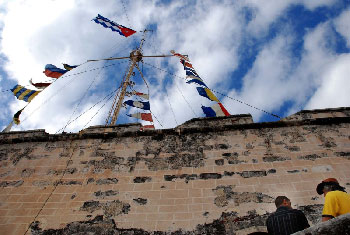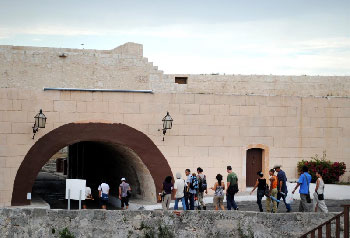The Fortified Walls of Cuba’s Political Regime
Haroldo Dilla Alfonso*

HAVANA TIMES — There is at least one similarity between the way in which the fortresses of old organized their defensive structures and the manner in which some contemporary political regimes protect themselves.
Fortresses would often delimit a defensive area known as a buffer zone, a slope which ran downward from the structure and which was generally as long as the reach of cannon fire. This slope was a strict zone of exclusion where no permanent constructions were permitted and, ultimately, no marauders were allowed.
Political regimes also build such defensive inclines, and their symbolic buffer zones are areas where individuals are controlled and repressed.
As one would expect, the fortresses of yesteryear, besieged by neighboring societies whose populations grew and diversified, were forced to constantly redefine their zones of exclusions. Accordingly, their buffer zones would gradually shrink, beginning at a conventional width of around one kilometer and ending up at a few hundred meters.
The walls of these fortifications would finally come down, the buffer zones be transformed into run-of-the mill real estate and the castles turned into attractions for wide-eyed tourists.
When political regimes are flexible and creative, they do the same: they redefine their buffer zones, reducing areas of exclusion and integrating dissidents (though they may always retain a defensive zone without which, in their eyes, all hell would break loose).

Evidently, Cuba’s political regime has not followed this last tradition. Without a single flexible bone in their bodies, Cuban leaders, just like the obstinate administrators of yesterday’s fortresses, continue to hunt like rabbits those who prowl about their broad buffer zone.
In other words, even though Cuban society has changed dramatically, they want to continue running the show like they did before the 1990s, when they controlled social mobility and political discourse down to the minutest details.
They are unwilling to part with their totalitarian methods, even though Cuban society no longer allows for such control, and they themselves are unable to exercise it.
The problem faced by Cuba’s leadership is that both Cuban society and its political system have changed.
It’s not simply a question of growing social dissatisfaction with the government’s political and economic ineptness, and that this expresses itself as an avalanche of unorganized discontent that pushes some of the country’s best minds to emigrate. Nor is it limited to the fact that some spaces for private enterprise have been opened up.
The problem is that the very coordinates of social power and the configuration of political spaces have changed, and that a good part of the population – which has no intention of leaving – expects a political change that will give voice to their legitimate aspirations.
Cuban society is riven by variables arising from public and private undertakings which were unthinkable two decades ago. All of this, in a broad sense, is political.

There is now a determined opposition – active in public spaces, both real and virtual – which is evidently here to stay. There are now spaces where critiques of the regime – moderate, of course – may be formulated, which are highly innovative in cultural terms and which regularly address the State with the demands of different social sectors.
Finally, we’re also seeing that Granma, Cuba’s main newspaper, called “unusual situations”, developing in the fissures of the country’s “revolutionary moral code”, which go from luxury-filled, glamorous galas thrown by a jet-set of nouveaux riche to the mad ravings of a pastor who entrenched himself in his Church, with his flock, to await the coming of the Messiah.
The challenge faced by the Cuban leadership is to transform the current political regime – gradually but consistently – into a pluralist system without political exclusion.
If it fails to do this, Cuban society will continue to be confined by a sinister situation in which individuals are made to endure a form of control that is incompatible with their education and their political awareness, and entirely incongruous with the world we all live in.
It will continue to suffer the pangs of a society scourged by extremisms, polarization, exclusion and the concept that all dissenting thought is a form of treason – and the island’s population will continue to dwindle, and apathy and cynicism will continue to be the hard currency of its political market.
In order to do this, the Cuban leadership would need something which, I’m sorry to say, it currently does not have: a strategic vision for the nation which can point the way in a realistic, democratically-determined manner.
Without it, they will likely continue behind thick walls, scrutinizing their buffer zone from a distance, forbidding any type of construction there and repressing anyone caught prowling around the area.
—–
(*) Published originally in Spanish by Cubaencuentro.com.





